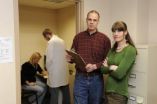(Press-News.org) Nele Festjens and Nico Callewaert of VIB and Ghent University have improved the efficacy of the vaccine for tuberculosis. The new vaccine affords - as already proven in mice - better protection against the disease. The development of a new tuberculosis vaccine is a priority in the fight against the disease which claims the lives of 1.7 million people each year. The current vaccine provides only partial protection.
Nico Callewaert: "Our vaccine is more effective because it is more quickly recognized by the immune system of the vaccinated person. We have, as it were, undressed the existing vaccine by removing its protective shield."
Tuberculosis: a worldwide problem
One third of the world population is infected with the Mycobacterium tuberculosis bacterium which causes tuberculosis (TB). TB, AIDS and malaria are the three infectious diseases claiming the largest number of fatalities worldwide. The World Health Organization (WHO) estimates that each year 8 to 10 million people become infected. TB is in particular a disease of the poor and mainly affects young adults in their most productive years. Most TB fatalities are in the developing countries, more than half of them in Asia. In almost all of these countries, multidrug-resistant TB is becoming increasingly frequent. This form of TB is very hard to treat.
Prevention is better than cure
TB treatments are expensive and also very difficult because of multidrug-resistant TB. There has therefore been a strong focus on vaccination in the fight against TB. The only vaccine on the market is Bacillus Calmette-Guérin (BCG). It is produced from attenuated live bovine tuberculosis bacterium, Mycobacterium bovis, which has lost its virulence in humans. In children, the vaccine prevents only half of cases of tuberculosis and in adolescents and adults the degree of protection is much lower still.
In recent years, several other candidate vaccines have been developed and some of these have been tested on humans. Only a few have led to a moderate improvement in protection compared with the BCG vaccine. The search for a more efficient vaccine is therefore still on.
Removing the bacterium's defense shield
The bacterium from which the BCG vaccine is derived hides as it were from the immune system of the organism in which it ends up. This may well be the reason why the vaccine is not very effective. The fact is that a vaccine is meant to trigger an immune reaction in order to be able to afford good protection. Nele Festjens and Nico Callewaert have discovered that the bacterium hides behind the SapM enzyme that acts as a kind of shield.
They have used this knowledge to develop a new vaccine. They adapted Mycobacterium bovis BCG in such a way that it was no longer able to generate SapM and could therefore no longer hide from the immune system. Testing the new vaccine on mice has shown that it affords better protection than the present BCG vaccine.
A different mechanism
The researchers also demonstrated that their vaccine works in a way different from the other vaccines currently being tested. In fact, it acquires its extra protective value by emitting signals that provoke inflammation and in this way activate the right cells of the immune system. Festjens and Callewaert are convinced that applying their strategy - removing the protective shield - in the new vaccines that are somewhat better than the vaccine currently being marketed should lead to a vaccine that affords genuine protection against TB.
INFORMATION:
More information on www.vib.be/nico-callewaert
Questions
Considering that this research may raise many questions from patients, we would like to request that in your report or article, you refer to the e-mail address VIB makes available for these questions. Everyone is welcome to send questions about our research to: patients@vib.be
Note to the editor
Credits
When reporting on this research, please mention all partners involved.
VIB
VIB is a non-profit research institute in the life sciences in Flanders, Belgium, with 1200 scientists conducting strategic basic research on the molecular mechanisms that are responsible for the functioning of the human body, plants, and micro-organisms. Through a partnership with four Flemish universities – Ghent University, the Katholieke Universiteit Leuven, the University of Antwerp, and the Vrije Universiteit Brussel − and a solid funding program, VIB unites the forces of 72 research groups in a single institute. Through its technology transfer activities, VIB strives to convert the research results into products for the benefit of consumers and patients. VIB develops and disseminates a wide range of scientifically substantiated information about all aspects of biotechnology. For more information, please visit www.vib.be.
Ghent University
After more than twenty years of uninterrupted growth, Ghent University is now one of the most important institutions of higher education and research in the Low Countries. Ghent University yearly attracts over 30,000 students, with a foreign student population of over 2,200 EU and non-EU citizens. Ghent University offers a broad range of study programs in all academic and scientific fields. With a view to cooperation in research and community service, numerous research groups, centers and institutes have been founded over the years. For more information www.UGent.be.
Relevant scientific publication
The study is reported in the authoritative journal EMBO Mol. Med (Festjens et al., Disruption of the SapM locus in Mycobacterium bovis BCG improves its protective efficacy as a vaccine against M. tuberculosis)
Funding
This study has partly been funded by the Marie Curie Excellence Grant (EU FP6), Methusalem, FWO, UGent and VIB.
The study was conducted by Nele Festjens and colleagues under the direction of Nico Callewaert at the VIB Department for Molecular Biomedical Research, UGent. In collaboration with Dr. Kris Huygen from the Scientific Institute of Public Health.
END
Parents and caregivers have traditionally relied on cribs, playpens and bassinets to protect children while they sleep. The massive crib recalls followed by the announcement in December 2010 by the United States Consumer Product Safety Commission (CPSC) to ban drop-side cribs have caused many families to question the safety of these products. A new study conducted by researchers at the Center for Injury Research and Policy of The Research Institute at Nationwide Children's Hospital examined injuries associated with cribs, playpens and bassinets among children younger than ...
Inducing labor without a medical reason is associated with negative outcomes for the mother, including increased rates of cesarean delivery, greater blood loss and an extended length of stay in the hospital, and does not provide any benefit for the newborn. As the number of scheduled deliveries continues to climb, it is important for physicians and mothers-to-be to understand the risks associated with elective induction.
The new findings, published in the February issue of the Journal of Reproductive Medicine, only apply to women having their first child, and may not ...
BUFFALO, N.Y. -- Among the many differences between girls and boys, add the effects from caffeine -- physiological, behavioral and subjective -- to the list.
Results of a double-blind, placebo-controlled, dose-response study of the response of youth to caffeine found that, in general, boys get a greater rush and more energy from caffeine than girls.
Boys also reported they felt that caffeine had a positive effect on their athletic performance. Girls didn't report on this issue.
The study, conducted by Jennifer L. Temple, PhD, a neurobiologist and assistant professor ...
Unlike alcohol problems and antisocial behavior, depression doesn’t
decline with age in addiction-prone women in their 30s and 40s – it
continues to increase, a new study led by University of Michigan Health
System researchers found.
The longitudinal analysis examined the influences of the women’s
histories, family life and neighborhood instability on their alcoholism
symptoms, antisocial behavior and depression over a 12-year period
covering the earlier years of marriage and motherhood.
The research, published in Development and Psychopathology, is part of
an ...
ROCHESTER, Minn. - Mayo Clinic researchers confirmed that patients who receive therapeutic hypothermia after resuscitation from cardiac arrest have favorable chances of surviving the event and recovering good functional status. In therapeutic hypothermia, a patient's body temperature is cooled to 33 degrees Celsius following resuscitation from cardiac arrest, in order to slow the brain's metabolism and protect the brain against the damage initiated by the lack of blood flow and oxygenation. This study was published in the December 2010 issue of Annals of Neurology.
"Therapeutic ...
AMES, Iowa -- Why would anyone falsely confess to a crime they didn't commit? It seems illogical, but according to The Innocence Project, there have been 266 post-conviction DNA exonerations since 1989 -- 25 percent of which involved a false confession.
A new Iowa State University study may shed light on one reason for those false confessions. In two experiments simulating choices suspects face in police interrogations, undergraduate subjects altered their behavior to confess to illegal activities in order to relieve short-term distress (the proximal consequence) while ...
Yet some athletes deliberately train at high altitude, with less oxygen, so they can perform better. Their bodies adapt to the reduced oxygen.
Now a doctor at the University of Colorado School of Medicine has explored the relationship between lack of oxygen, called hypoxia, and the inflammation that can injure or kill some patients who undergo surgery. In a liver transplant, for example, the surgery and anesthesiology can go perfectly yet the new liver will fail because of hypoxia.
"Understanding how hypoxia is linked to inflammation may help save lives of people who ...
A powerful solar flare has ushered in the largest space weather storm in atleast four years and has already disrupted some ground communications on Earth, said University of Colorado Boulder Professor Daniel Baker, an internationally known space weather expert.
Classified as a Class X flare, the Feb. 15 event also spewed billions of tons of charged particles toward Earth in what are called coronal mass ejections and ignited a geomagnetic storm in Earth's magnetic field, said Baker, director of CU-Boulder's Laboratory for Atmospheric and Space Physics. Such powerful ejections ...
When studying relationships, psychological scientists have often focused on how couples fight. But how they recover from a fight is important, too. According to a new study published in Psychological Science, a journal of the Association for Psychological Science, couples' abilities to bounce back from conflict may depend on what both partners were like as infants.
Researchers at the University of Minnesota have been following a cohort of people since before they were born, in the mid-1970s. When the subjects were about 20 years old, they visited the lab with their romantic ...
LOS ANGELES (February 18, 2011) – Scientists at the Children's Center for Cancer and Blood Diseases and The Saban Research Institute of Children's Hospital Los Angeles today announced a breakthrough discovery in understanding how the body fights leukemia. They have identified a protein called CD19-ligand (CD19-L) located on the surface of certain white blood cells that facilitates the recognition and destruction of leukemia cells by the immune system. This work represents the first report of a bioengineered version of CD19-L, a recombinant human biotherapeutic agent, ...


